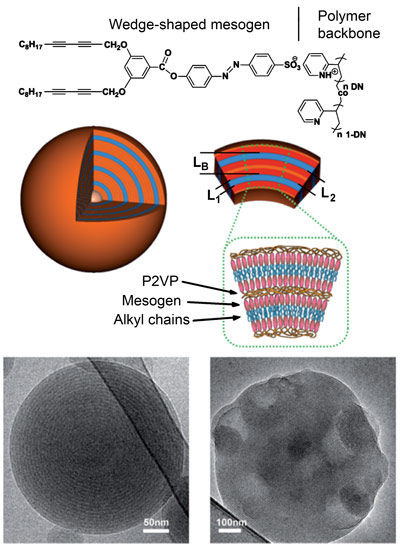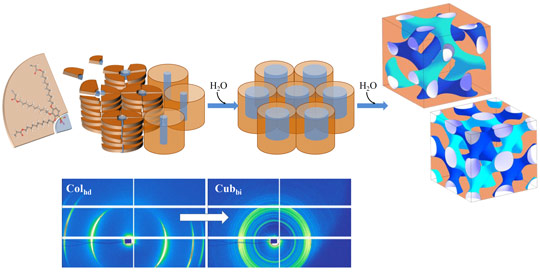- Home
- News
- Spotlight on Science
- Assembling molecular...
Assembling molecular wedges: the route towards new nano-structured functional materials
20-12-2013
Self-assembly of designer monomers in the liquid phase can be used as the first step in the creation of supramolecular systems. Polymerisation of these assemblies creates a permanent structure, leading to novel functional materials. Scientists working at beamline BM26B take a closer look at these complex structures.
Share
The topology of the fluid phase in complex nanostructured liquids is important for a variety of practical applications ranging from drug delivery to biocatalysis, pharmaceutics, and membrane technology.
The supramolecular assembly of low molecular weight organic liquid crystals is known to generate a large diversity of structures. For example, wedge-shaped molecules bearing polar groups at the tip of the hydrophobic wedge can form smectic layers such as the ones in the cell membrane or in cylindrical superstructures with the polar groups arranged along the cylinder axis. By changing the design of the molecular wedges, the structure of the system can be fine-tuned for a particular application [1-4].
We have already studied the organisation of some new low molecular weight wedge-shaped molecules (Figure 1, top) using several facilities at the ESRF [5,6]. Targeting the control of the polymer stereochemistry by the solid-state organisation of the monomers, we have shown that the molecular wedges bearing diacetylene moieties can undergo topochemical polymerisation with only minimal structural rearrangements. In this study, by employing the versatile spatially-resolved wide-angle X-ray diffraction setup of beamline BM26B, we found that the diacetylene units are oriented along a defined crystallographic direction with a reticular distance of 4.85 Å, which fulfills the requirements for the topochemical polymerisation.
Furthermore, using the small-angle setup of BM26B we demonstrated that a liquid-crystalline complex of a polybase such as poly(2-vinylpyridine) (P2VP) and amphiphilic wedges bearing sulfonic acid groups at the tip (Figure 1 top) forms onion-like multilamellar nano-sized vesicles in aqueous suspension. The structure of the complex in the vesicles is found to be similar to that in the bulk, where the polymer backbones are sandwiched between the bilayers formed by the ligand molecules. In contrast to conventional polymersomes, the polymer chains in this system are mainly parallel to the vesicle surface, contributing to their mechanical stability (Figure 1, middle). A large amount of remaining free binding sites (i.e. pyridine groups of the backbone) makes it possible to incorporate different functional molecules into the vesicles. Furthermore, a collapse of the vesicles can be induced by UV irradiation because of the trans–cis transition of the azo groups, which leads to isotropisation of the layered structure (Figure 1, bottom). This feature can make the system promising for controlled delivery applications.
We also explored the sequence of humidity-induced phase transitions in a novel wedge-shaped sulfonate molecule, sodium 2,3,4-tris (11’-acryloylundecyl-1’-oxy) benzene sulfonate (A-Na) (Figure 2, left). This molecule serves as a model of a nano-channel-forming ion-selective membrane. We found that even a small amount of water can efficiently create highly conductive pathways for ions in the supramolecular system containing ionic nano-channels. Moreover, swelling of the initial hexagonal structure (Colhd) by water gives rise to a phase transition to bicontinuous phases (Cubbi), which is accompanied by the formation of a percolating network of ion-conductive paths. The appearance of Cubbi phases on swelling further improves the conductivity, and can be of much interest for membrane technologies. Unlike columnar phases, the Cubbi phases would not require macroscopic channel alignment to maximise ion transport due to their interwoven 3D channel networks. These results provide a detailed view of the processes occurring in an ion-channel-forming system upon swelling. Importantly, it was shown that the supramolecular structures such as Colhd and Cubbi phases can be preserved upon polymerisation of acrylic end-groups resulting in free-standing membranes with efficient ion-conduction. This work paves the way for fabrication of mechanically-stable nanoporous membranes with a tailored ion channel structure for applications in separation and catalysis.
Principal publication and authors
From channel-forming ionic liquid crystals exhibiting humidity-induced phase transitions to nanostructured ion-conducting polymer membranes, J.J. Hernandez (a), M. Rosenthal (a,b), D.A. Ivanov (a,b), H. Zhang (c), L. Li (c), M. Möller (c) and X. Zhu (c), Adv. Mat. 25, 3543-3548 (2013).
(a) Institut de Sciences des Matériaux de Mulhouse (IS2M-CNRS) (France)
(b) Moscow State University Faculty of Fundamental Physical and Chemical Engineering GSP-1, Moscow (Russian Federation)
(c) Interactive Materials Research - DWI an der RWTH Aachen e.V. and Institute for Technical and Macromolecular Chemistry of RWTH Aachen University (Germany)
(d) Macromolecular Chemistry II, University of Bayreuth (Germany)
References
[1] Beginn, U. Prog. Polym. Sci. 2003, 28, 1049.
[2] Angelova, A.; Angelov, B.; Mutafchieva, R.; Lesieur, S.;Couvreur, P. Acc. Chem. Res. 2010, 44, 147.
[3] Ungar, G.; Liu, Y.; Zeng, X.; Percec, V.; Cho, W.-D. et al. Science 2003, 299, 1208.
[4] Percec, V.; Dulcey, A. E.; Balagurusamy, V. S. K.; Miura, Y.; Smidrkal, J.; Peterca, M.; Nummelin, S.; Edlund, U.; Hudson, S. D.; Heiney, P. A.; Duan, H.; Magonov, S. N.; Vinogradov, S. A. Nature 2004, 430, 764.
[5] M. Rosenthal, L. Li, J.J. Hernandez, X. Zhu, D.A. Ivanov and M. Möller, Chem. Eur. J. 19, 4300-4307 (2013).
[6] L. Li, M. Rosenthal, H. Zhang, J.J. Hernandez, M. Drechsler, K.H. Phan, S. Rütten, X. Zhu, D.A. Ivanov, and M. Möller, Angew. Chem.: Int. Ed. 124, 11784 –11787 (2012).
Top image: Complex materials from self-assembled molecular wedges.





